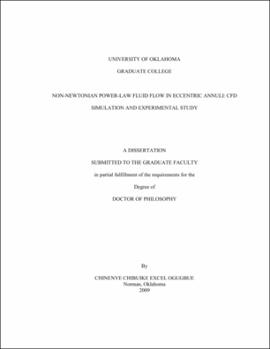| dc.contributor.advisor | Shah, Subhash N. | |
| dc.creator | Ogugbue, Chinenye Excel Chibuike | |
| dc.date.accessioned | 2019-05-01T17:22:58Z | |
| dc.date.available | 2019-05-01T17:22:58Z | |
| dc.date.issued | 2009 | |
| dc.identifier | 99111994002042 | |
| dc.identifier.uri | https://hdl.handle.net/11244/319407 | |
| dc.description.abstract | Numerous publications have addressed the problems inherent to calculating wellbore hydraulics in eccentric annulus. The challenge of theoretical and numerical studies of fluid flow in an eccentric annulus is mainly due to the required coordinate systems. CFD modeling provides an alternative approach of investigating fluid flow in such complex geometries. The CFD technique emerged as a result of the current increase in computer processing speed and available memory. This branch of fluid flow analysis complements experimental and theoretical work, providing economically interesting alternatives through the simulation of real flows and allowing an alternative form for theoretical advances under conditions unavailable experimentally. | |
| dc.description.abstract | In this study, results from a series of numerical simulations for the fully developed laminar flow of non-Newtonian power law fluids in eccentric annular geometries, conducted using the computational fluid dynamics (CFD) code FLUENT, are used to investigate the effect of eccentricity, and diameter ratios (ratio of the outer diameter of the inner tubing to the inner diameter of the outer tubing) on axial velocity profiles, the viscosity profile, as well as the axial friction pressure losses. Unlike the uniform velocity profile applicable for every sector in a concentric annulus, the axial velocity profile for an eccentric annulus is altered, with the peak velocities varying with location. A virtual inspection of the velocity profiles in an eccentric annulus shows that the zone of highest shear exists across the narrowing sector of an eccentric annulus; hence this region is noticeably accompanied by a considerable reduction in viscosity. | |
| dc.description.abstract | The friction pressure gradients predicted by the CFD simulations were verified by comparing with the published studies and flow data from a field scale experimental data of a fully eccentric annulus. At a constant flow rate, it is confirmed that frictional pressure losses are decreased with increasing eccentricity. Also, fluids with the stronger non-Newtonian property show a slower rate of decrease in pressure drop as eccentricity increases. A good agreement is obtained with the Haciislamoglu et al. correlation, and the results of this study, especially at low values of eccentricity. At very high eccentricities, data from the CFD model yields lower friction pressure compared to Haciislamoglu et al. correlation. A Haciislamoglu et al. type expression is obtained, incorporating the improved data of this study. | |
| dc.description.abstract | Next, the results of an experimental study carried out to investigate friction pressure behavior of drag reducing polymer solutions flowing turbulently through an eccentric annulus are presented. The experimental set-up includes 30 ft of 3½-in. x 2 3/8-in., 200 ft of 3½-in. x 1¾-in., 69 ft of 5½-in. x 4-in., and 79 ft of 5-in. x 3½-in. fully eccentric annuli. Data analysis enabled the development of a new correlation using Fanning friction factor, generalized Reynolds number, and diameter ratio, all of which can be easily determined in the field, as independent variables. These new correlations for laminar and turbulent flow of drag reducing polymer solutions present an improvement to existing correlations, and also permit undemanding hydraulic program calculations for varying annular configurations. | |
| dc.format.extent | 178 pages | |
| dc.format.medium | application.pdf | |
| dc.language | en_US | |
| dc.relation.requires | Adobe Acrobat Reader | |
| dc.subject | Computational fluid dynamics | |
| dc.subject | Non-Newtonian fluids | |
| dc.subject | Boring | |
| dc.subject | Hydraulics | |
| dc.subject | Computational fluid dynamics | |
| dc.title | NON-NEWTONIAN POWER-LAW FLUID FLOW IN ECCENTRIC ANNULI: CFD SIMULATION AND EXPERIMENTAL STUDY | |
| dc.type | text | |
| dc.type | document | |
| dc.thesis.degree | Ph.D. | |
| ou.group | Mewbourne College of Earth and Energy::Mewbourne School of Petroleum and Geological Engineering | |
